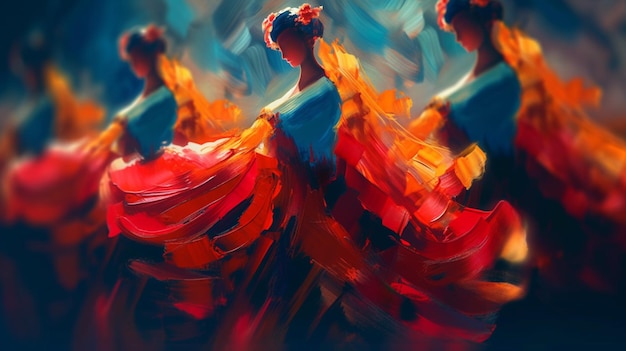Flamboyance, a term often associated with extravagant expression and vibrancy, is a multifaceted aspect of personality that deserves a more profound exploration. It encompasses various elements, including charisma, creativity, confidence, and uniqueness. This paragraph aims to shed light on the true essence of flamboyance by examining its core components and their impact on individuals who embody this trait.
Quick Read
Expression
One of the most striking features of flamboyant individuals is their expressive nature. They are not afraid to show their emotions, beliefs, and opinions openly and boldly. Their verbal communication is eloquent and articulate, while their nonverbal expressions, such as facial expressions, body language, and tone of voice, convey a deep sense of authenticity and passion.
Vibrancy
Another defining characteristic of flamboyance is its vibrant energy. Flamboyant individuals have a zest for life and a contagious enthusiasm that brightens up any room they enter. They embrace color, patterns, and textures in their clothing, surroundings, and social interactions, creating a visually stimulating world around them.
Confidence
A key element of flamboyance is the unwavering confidence that its possessors exude. They believe in themselves and their abilities, which allows them to take risks, challenge the status quo, and embrace new experiences without fear or hesitation. This self-assuredness stems from a deep understanding of their unique identity and the value it brings to the world.
Uniqueness
Lastly, flamboyance celebrates the uniqueness of each individual. It encourages people to be true to themselves and express their individuality without apology or compromise. By embracing their quirks, passions, and idiosyncrasies, flamboyant individuals inspire others to do the same, fostering a more diverse and inclusive world.
Flamboyance: Expression Beyond the Norm
Flamboyance, a term that has its roots in the late 19th century, is a style of expression characterized by extravagance, vividness, and theatricality. Initially used as a descriptive term for homosexual men, flamboyance has since evolved and broadened to encompass various expressions of personality. Its historical context is deeply intertwined with societal norms, challenging them in ways that continue to inspire creativity and promote individuality.
Definition of Flamboyance
The term “flamboyance” emerged as a descriptive term during the late 1800s, primarily in reference to homosexual men who exhibited feminine or theatrical traits. However, flamboyance is not limited to this context and has since expanded to include any form of expression that embodies extravagance, vividness, and theatricality.
Historical Context: Origins of Flamboyance
Originating in the late 19th century, flamboyance was first used to describe homosexual men who defied societal norms by exhibiting feminine or theatrical traits. However, its historical context is much more complex than this narrow definition suggests. Flamboyance has often been associated with artistic expression and creativity, as well as resistance to societal conventions and expectations.
Flamboyance and Societal Norms
Throughout history, flamboyance has challenged societal norms by promoting individuality and expression beyond the accepted boundaries. By embracing extravagant, vivid, and theatrical forms of self-expression, individuals who identify as flamboyant have contributed to cultural advancements in art, fashion, music, and literature.
Importance of Flamboyance
An exploration of flamboyance is essential for understanding the complex history and societal impact of this expressive style. By examining its origins, evolution, and contemporary relevance, we can gain a deeper appreciation for the ways in which flamboyance challenges norms, inspires creativity, and promotes individuality.
Origins and Evolution of Flamboyance
Historical Roots:
The term “flamboyant” has its origins deeply rooted in various aspects of literature, art, and society. As early as the 15th century, the word was used in French to describe something that is brilliantly or excessively decorated with showy colors, making it an apt description for those who dared to stand out. In literature, the term was used to describe extravagant characters and their florid language in the 16th and 17th centuries. In art, particularly during the Baroque period, flamboyance was synonymous with the ornate decorative style that characterized much of the visual arts of the time.
Cultural Significance:
Throughout history, flamboyance has held significant cultural importance in different communities. In the LGBTQ+ community, flamboyance has often been a form of resistance and self-expression. The flamboyant gay men who defied societal norms in the early 20th century paved the way for greater acceptance and visibility of queer identities. In African American culture, the term has been used to describe a style of self-presentation that is bold, expressive, and full of life, reflecting the community’s rich heritage and resilience. In the fashion industry, flamboyance has been a constant source of inspiration, with designers like Vivienne Westwood and Marc Jacobs incorporating bold colors, patterns, and shapes into their collections.
Modern Perspective:
Today, the concept of flamboyance continues to evolve and shape contemporary society in various ways. Flamboyance is often seen as a form of gender expression that transcends traditional binary definitions, challenging societal norms and expectations. It can be found in the way people dress, talk, move, and even think. Flamboyance has also influenced popular culture, from music and film to literature and advertising. However, despite its ubiquity and increasing acceptance, flamboyance is still sometimes stigmatized or misunderstood, highlighting the need for continued dialogue and education around issues of gender expression and identity.

I Characteristics of Flamboyance
Flamboyance is a vibrant and expressive attitude that shines through in individuals who embrace grandiosity, opulence, and dramatic flair. Extravagance, a key component of flamboyance, is the deliberate use of grandiosity and
Vividness: Bringing Flamboyance to Life
The vividness of flamboyant expression is characterized by a rich use of color, art, and creativity. Color, in particular, plays a crucial role in conveying the energy and intensity of flamboyance. Whether it’s through bold and bright clothing or the use of vibrant accents in home decor, color is a powerful tool for expressing flamboyance.
Theatricality: Embodying Flamboyance through Performance
Finally, the theatricality of flamboyance is expressed through performance, drama, and entertainment. Flamboyant individuals often embrace the stage as a means of self-expression, whether that’s through singing, acting, or dancing. The art of performance allows flamboyant people to fully embody their expressive nature, captivating audiences with their energy and charisma.

Expression of Flamboyance in Various Contexts
Flamboyance, a term often used to describe extravagant, ostentatious, and theatrically expressive behavior, can be observed in various aspects of life. This expressive quality transcends boundaries and manifests in multiple contexts. In this exploration, we’ll delve into three primary areas: Fashion, Language, and Performance.
Fashion:
The realm of fashion is an excellent platform to express flamboyance through clothing, accessories, and personal style. Bold colors, intricate patterns, and eye-catching designs can all contribute to a flamboyant look. For instance, a person might wear a bright pink tutu, sequined jacket, or feathered headpiece to turn heads and showcase their exuberant personality. Accessorizing with large jewelry pieces, extravagant hats, or statement shoes can further amplify the flamboyant expression.
Language:
Language is another powerful tool in conveying flamboyant expressions. Through the use of slang, vernacular, and colorful language, individuals can add depth and dimension to their communication style. Words and phrases that are distinct to specific communities or subcultures can help forge connections and create a sense of belonging among like-minded people. For instance, the term “fabulous” is commonly associated with flamboyance and has its roots in the LGBTQ+ community.
Performance:
Performance arts, such as dance, music, and theater, are essential mediums for expressing and celebrating flamboyance. Through elaborate costumes, dramatic movements, and captivating vocals or instrumental skills, artists can transport audiences to a world of unbridled expression and creativity. In dance, flamboyant moves might include exaggerated gestures, high kicks, or sultry spins that draw attention to the performer’s energy and enthusiasm. In music, flamboyant expressions might involve belting out a powerful vocal run or incorporating playful, unconventional lyrics to add personality and charm to a song. Theater, meanwhile, offers actors the opportunity to embody flamboyant characters, providing a space for audiences to experience a heightened sense of emotion and spectacle.

The Impact of Flamboyance on Society
Flamboyance, a term often associated with extravagant expression and exuberant personality traits, has long been a topic of fascination in various aspects of society. Its impact reaches far beyond personal interactions and touches on important societal norms and expectations, particularly those related to gender and sexuality.
Challenging Stereotypes:
By flouting societal conventions and expectations, flamboyant individuals challenge the status quo, opening doors for new perspectives on gender and sexuality. Their bold self-expression invites others to question their own assumptions, potentially leading to a more inclusive and accepting society.
Inspiring Creativity:
Art:
From painting to music, the flamboyant spirit has influenced countless artists throughout history. By embracing their unique personalities and pushing boundaries, these creatives have left a lasting impact on the arts.
Design:
In the realm of design, flamboyance can manifest in bold color palettes, intricate patterns, and unconventional shapes. This fearless approach to aesthetics challenges preconceived notions and sparks inspiration in both professional designers and everyday consumers.
Promoting Individuality:
Flamboyance empowers individuals to embrace their unique personalities and express themselves freely. By embracing the full spectrum of human emotion and expression, it encourages a deeper understanding of individual identities and fosters a more compassionate and inclusive society.
Empowerment:
Flamboyant individuals serve as role models for those who may feel stifled by societal expectations. By seeing others fearlessly expressing themselves, they are inspired to do the same and reclaim their personal power.
Fostering Inclusivity:
As society continues to evolve, the acceptance and celebration of flamboyant expression will only grow stronger. This shift towards greater inclusivity and self-expression is essential in creating a world where everyone feels seen, heard, and valued.
Embracing Diversity:
The impact of flamboyance on society is far-reaching and multifaceted. It challenges stereotypes, inspires creativity, and promotes individuality. By embracing the diversity that comes with this expressive spirit, we can create a more compassionate and inclusive world.
VI. Conclusion
Summary of Key Points: In this essay, we have explored the concept of flamboyance and its historical context. We discussed how flamboyance emerged as a form of resistance against societal norms, particularly in the queer community. We also delved into the significance of flamboyance in various fields such as fashion, art, and music. Flamboyance, as we have seen, is a powerful expression of individuality that challenges the status quo and encourages self-expression.
Reflections on the Significance of Flamboyance:
The importance and relevance of flamboyance in contemporary society cannot be overstated. In a world that is increasingly diverse and inclusive, flamboyance serves as a reminder of the importance of embracing individuality and challenging societal norms. With the rise of movements such as queer culture, gender fluidity, and body positivity, flamboyance has become a symbol of resistance against the rigid gender binary that dominates our society. It is also a testament to the power of creativity and self-expression, and its potential for further evolution and influence is limitless.
Encouragement to Embrace Flamboyance:
Lastly, we would like to encourage each and every one of you to celebrate your own expressions of flamboyance. Whether it’s through the way you dress, the way you speak, or the way you express yourself, remember that every individual is unique and deserving of respect. Let us strive to create a world where everyone can express themselves freely, without fear of judgment or discrimination. Embrace your inner flamboyance and let it shine brightly!




